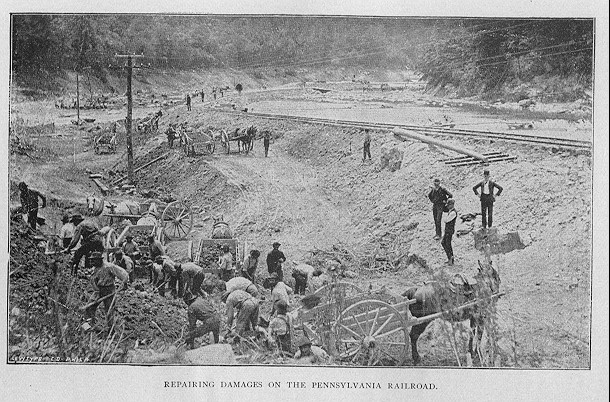
History of the Johnstown Flood
By Willis Fletcher Johnson
Chapter 42
|
The diary of Johnstown since the tragedy is filled with records of work and progress toward rebuilding and restoration. A few days after the flood the Cambria Company ordered two million feet of lumber to build homes for their employees. On June 10th they started up their furnaces for the first time since the flood. The furnaces were little injured. Most of the rest of the works were still filled with debris, and some of the buildings will have to be torn down and rebuilt. Thousands of men were at work getting the other departments in order as fast as possible. All possible speed was used in getting the works going, not only in order to provide employment for the people there, but also to prevent the shutting down of other large manufactories in the East, which were dependent upon the Cambria Works for their supply of raw material. One reason for the extraordinary haste of the Pennsylvania Railroad in getting this part of its road open was the necessity for furnishing transportation for these works, contracts representing millions of dollars being involved in the prompt delivery of the steel and iron they manufacture. Haws & Co.'s large brick kilns and cement works, along the bank of the river opposite the Cambria works started up on June 11th. They were on high ground and were uninjured by the flood, but had been suspended because all the workmen were either drowned or put out of condition for work by the flood. General Hastings personally urged all employers in the city to get their works going as soon as possible, in order to make the people as nearly as may be self-supporting. The Pennsylvania Railroad re-opened its offices in its station on June 10th. The building had been used since the flood as a morgue and supply station. The telegraph office was moved from its ten-by-fifteen foot coal-shed, at the south end of the bridge, to more permanent quarters in the Cambria Iron Company's office near the railroad station. The ceiling of the office was smashed and covered with queer white spots upon a muddy background. The desks in the office all went sailing to the ceiling when the flood came, and smashed the plaster. Pictures were floated up against the ceiling, and being held fast there, kept the plaster under them white. The building was a very substantial one of brick, and was sheltered by the Wood, Morrell & Co.'s general store, which was partially destroyed, but which broke the force of the current.
A newspaper correspondent made this entry under the date of June 17th: “The Relief Committee have decided to erect a hundred portable houses to shelter the survivors as soon as the buildings can be received from Chicago. The houses will be twelve by twenty-six feet, and will be large enough to accommodate six persons each. Each house will be furnished with a stove and utensils, six chairs, two beds and bedclothes, two spring mattresses, one pair pillows, two pairs of sheets for each bed, woolen blankets, a bureau, a table, and table-ware to set it. In fact, a family will be given everything necessary to go to housekeeping, and told to go ahead and paddle their own canoe. The object is to start the town on toward a rise from the ruins, but as the town is yet in chaos, it is impossible to make permanent arrangements. The grade of the town may be raised. If a man cannot find his own ground now, he can set his house up anywhere, and move it on to his land when it is found under the debris. If the houses give satisfaction, the Committee will not stop at buying a thousand of them, and building up the town. In conjunction with this move at building up the ruined city, General Hastings has purchased an immense quantity of lumber, and will next Tuesday begin building shanty stores for those who will set up in business again. Over a hundred have already made applications. “Arrangements are now being made for the erection of a lock-up, which Burgess Hovell says will be filled as soon as completed with persons who have been filling their houses with valuables from the wreckage. Many citizens, who have hitherto been considered honest, are known to have entered wrecked houses and carried off valuables by the armful. As soon as Burgess can get his affairs straightened out, he says he will issue search-warrants, and every house that is suspected of containing booty will be turned wrong side up.” Two days later the situation was thus described: “Governor Beaver and the Flood Commission arrived here just before noon, and, accompanied by General Hastings, made a tour of the devastated district on horseback, dining afterward at headq1uarters. The visit of Governor Beaver and the Flood Commission has borne practical fruit. The visitors met the Finance Committee of the Citizens' Relief Committee at Alma Hall, and discussed the situation in all its details. The Commission expressed itself as amazed at the extent and completeness of the devastation, and pledged itself to render the citizens of the place all the aid in its power. The local Committee presented a list of their wants, and, after canvassing the demands, the Commission authorized the immediate purchase of five hundred of the Chicago ready-made houses on its account, and also the erection of all the stone buildings that may be asked for by local merchants. The Governor and Commission went immediately to their special train after the adjournment of the conference, and departed for Cresson, whence they will go on a trip through the other devastated districts of the State. “A big strike is imminent among the laborers employed upon the public works here. Trouble has been brewing for several days, in consequence not only of the scarcity of the food supply, but of the poor quality of the rations furnished, as well as dissatisfaction with the pay. This trouble culminated to-night at a meeting of the Booth and Flinn men, who are especially dissatisfied. They appointed a committee of five to wait upon General Hastings and request his good offices on their behalf. The committee made a long statement of their grievances. They claim that they had had nothing to eat since morning, and that the food that they do get is of an inferior quality. They also say that although they engaged to do work at the rate of one dollar and fifty cents per day, they are required to work on the drift at night without extra pay. They said that they should have one dollar and seventy-five cents per day, and requested General Hastings to intercede with their employers in their behalf, threatening to strike if their demands are not complied with. General Hastings promised to bring the matter to the attention of the contractors, but said that was all he could do. It is generally believed that the action taken presages a general strike unless the demand for one dollar and seventy-five cents per day is conceded.” The strike, it should be added, did not occur. More than six weeks after the catastrophe, another careful recorder made these observations: “Though the work already accomplished is great, as much or more remains undone. Only the lumber has been removed from the debris, while sand, dirt, bricks, and stones form a mass several feet thick over the whole town. Railroad cars and wrecked houses that were washed away from their foundations are still seen in various parts of town. “The rivers are half filled with debris, which has withstood all efforts to move it, and the wreck at the stone bridge is as bad in the bed of the stream now as it was against the bridge immediately after the flood. A few business houses have been erected in addition to the Park stands, but these are mostly plank structures composed of flood lumber, and fit only for stables. The people themselves have shelter for the present in one story ten and twenty houses without plastering or any other provision against the elements. “All these facts combine to make the most prominent citizens anxious as to the outcome. But notwithstanding this, there seems to be more than a desire on the part of the citizens to do their utmost to restore their homes and businesses. To this end some of the leading spirits are working to secure the consolidation of the fourteen boroughs. A report from the committee on this subject was to have been made last Monday, but was withheld or not made for good reasons. These reasons appear to be that Conemaugh borough opposes the scheme, and that some of the politicians in the others fear to let go their hold lest they never recover it. Nobody denies that it would inure to the benefit of all the boroughs to consolidate. It seems to be the only method by which the town will ever become what it was. Within the past few days the greatest barrier to consolidation has been overcome and, it is said, the committee will soon present a report that will meet with general approval. “Moxham, where are situated the Johnstown Company steel rail works, has had a boom since the flood. The place, situated about two miles south of the town, but was slightly injured by the water, and is connected with Johnstown by a rapid transit railroad. Most of the professional men have ordered houses to be erected here immediately. A select school will be opened, and all preparations are being made to accommodate the increased population. “Superintendent Duncan, of the street railway, is authority for the statement that the horse railway will be replaced by one operated by electricity. This was probably brought about by negotiations with T. L. Johnson, of the Johnson Steel Rail Company, who has been known to favor such a plan for some time, and who will likely become a heavy stockholder in the new arrangement.” The homes of the future Johnstown, said an observer as lately as July 25th, are likely to be built on high ground. The Cambria Iron Company is maturing a plan which, if consummated, will cause a great depression in real estate in the low-lying parts of the town. The company has a large tract of land on the Yoder Hill, just west of town, and the proposition is now to build an inclined plane from the center of the town to the top of the hill, a distance of probably three-quarters of a mile. Here five hundred acres of land can be laid out in pleasant building lots and as it will be convenient to the works, it is believed that all workingmen who can purchase a site will build their homes there.
|
|
 |
 |
|
|
|
-
Site Navigation
 Home
Home What's New
What's New Bible
Bible Photos
Photos Hiking
Hiking E-Books
E-Books Genealogy
Genealogy Profile
Free Plug-ins You May Need
Profile
Free Plug-ins You May Need
 Get Java
Get Java.png) Get Flash
Get Flash Get 7-Zip
Get 7-Zip Get Acrobat Reader
Get Acrobat Reader Get TheWORD
Get TheWORD
